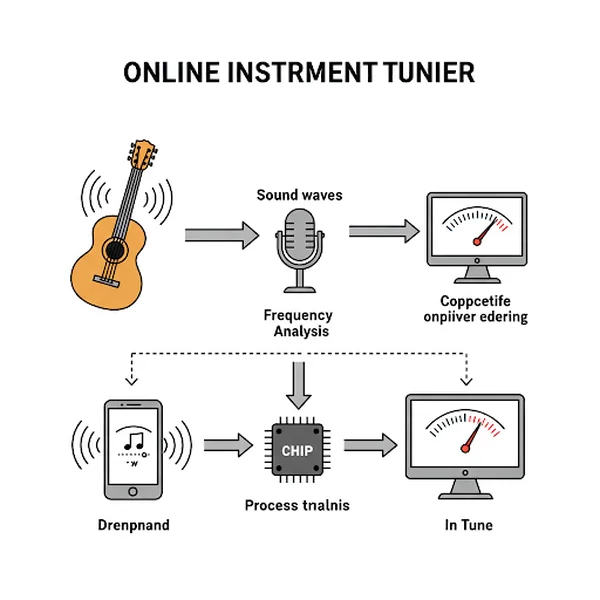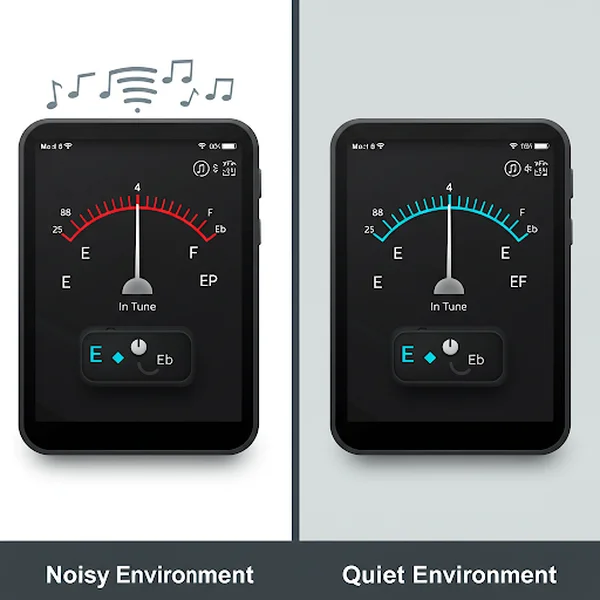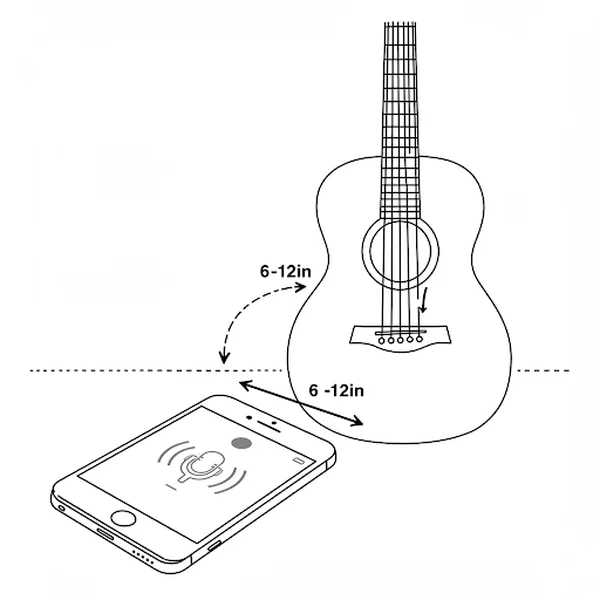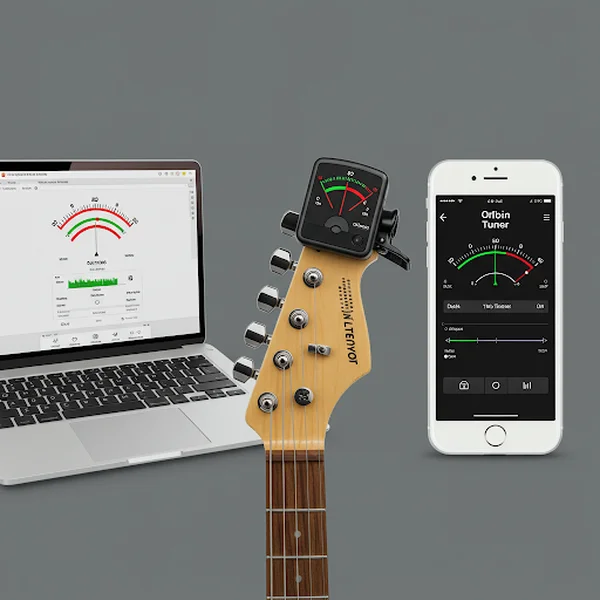Online Tuner Accuracy: Can You Trust Your Mic Tuner?
Online instrument tuners have become incredibly popular, offering a quick and convenient way to get your guitar, ukulele, bass, or other instrument in tune right from your browser. Tools like our online tuner put powerful tuning capabilities just a click away, often for free. But a common question lingers: just how accurate are these tuners, especially those relying on your device's microphone? Can you truly trust a tuner online for reliable pitch?
This article dives deep into the accuracy of online microphone tuners. We'll explore how they work, what factors influence their precision, and whether they are dependable enough for your musical needs.
How Do Online Microphone Tuners Actually Work?
Understanding the accuracy starts with knowing the basic process. When you use an online mic tuner, here's what happens behind the scenes:
Sound Capture: Your Device's Microphone Listens
First, the tuner needs to "hear" your instrument. You grant permission for the website to access your computer or phone's microphone. This microphone picks up the sound waves produced when you play a note.
Pitch Detection: Algorithms Analyzing Frequency
Once the sound is captured, sophisticated algorithms analyze the sound wave to determine its fundamental frequency. Frequency, measured in Hertz (Hz), is the scientific measure of pitch. For example, the standard A note (A4) is 440 Hz.
Visual Feedback: From Hertz to Musical Notes
The tuner's software then compares the detected frequency to the standard frequencies of musical notes (like E, A, D, G, B, E for a guitar). It instantly shows you which note you're closest to and whether you're sharp (too high), flat (too low), or perfectly in tune. This is the visual feedback you see on the screen, often as a needle or indicator, guiding your adjustments – just like the clear feedback provided by the instrument tuner here on our site.

Key Factors Influencing Online Tuner Accuracy
While the technology is clever, several factors can impact how accurately an online microphone tuner performs:
The Challenge of Background Noise Interference
Microphones pick up all nearby sounds, not just your instrument. Significant background noise (TV, talking, traffic) can interfere with the tuner's ability to isolate and analyze your instrument's specific frequency, potentially leading to inaccurate readings or jumpy indicators.

Microphone Quality: Built-in vs. External Mics
The quality of the microphone itself plays a role. While most modern built-in microphones on laptops and smartphones are surprisingly capable for basic tuning with a good tuner online, a higher-quality external microphone might offer slightly cleaner sound capture, especially in less-than-ideal environments. However, for most standard tuning tasks, your device's mic is usually sufficient when using a reliable online tuning tool.
Your Instrument's Tone and Sustain Properties
Instruments with very complex overtones or very short sustain (how long a note rings out) can sometimes be slightly harder for any tuner to read instantly. Playing the note clearly and letting it ring helps the tuner lock onto the fundamental pitch.
Device Processing Power and Potential Latency
While less of an issue on modern devices, very old computers or phones might have slight delays (latency) in processing the audio, although this rarely impacts basic tuning accuracy significantly.
Is a Free Online Tuner Accurate Enough for Practice & Performance?
So, the big question: are these tools, especially free ones like the tuner here, good enough?
Reliability for Daily Practice and Warm-ups
Absolutely. For routine practice, warming up, or simply ensuring your instrument is set to standard tuning (like EADGBE for guitar or GCEA for ukulele), a good online microphone tuner is generally very reliable and accurate enough.
Checking Standard Tuning Accuracy
They excel at confirming if each string is hitting the correct standard pitch. This is their primary and most common use case.
Limitations for Precise Intonation Setup
Setting a stringed instrument's intonation (ensuring it plays in tune all the way up the neck) requires extreme precision. While an online tuner can help identify major intonation problems, professional luthiers typically use highly sensitive strobe tuners (physical or high-end software) for this detailed work.
Viability for Quick Pre-Gig Tuning Checks
Yes. In a reasonably quiet backstage area, an online tuner is a perfectly viable option for a quick tuning check before you play. Its convenience is a major plus.
Tips for Maximizing Accuracy with Tuner.wiki (and similar online tools)
You can significantly improve the reliability of any online microphone tuner by following these simple tips:
-
Find a Quiet Space: Minimize background noise as much as possible. Turn off TVs, radios, and ask others to be quiet for a moment.
-
Position Your Instrument Close: Place your instrument's sound source (soundhole, bell, etc.) reasonably close (6-18 inches) to your device's microphone.

-
Pluck or Blow Clearly: Play one note at a time, clearly and with enough volume. Let the note sustain naturally; don't cut it off too quickly.
-
Ensure Mic Permissions: Double-check that your browser has permission to access the microphone for our tuner website.
-
Understand the Visual Feedback: Familiarize yourself with how the tuner indicates sharp, flat, and in-tune notes. See how the intuitive visual feedback works on our online tuner.
Online Tuner vs. App vs. Clip-On: A Quick Accuracy Comparison
How do online tuners stack up against other common options?
-
Convenience Factor: Online tuners win here – no installation needed, accessible anywhere with internet. Apps require installation. Clip-ons are physical devices you need to carry.
-
Environmental Noise Sensitivity: Clip-on tuners, which often work via vibration directly from the instrument, are the least affected by ambient noise. Both online tuners and tuner apps rely on microphones and are more susceptible to background sounds.
-
Potential Accuracy Levels: For standard tuning, the potential accuracy of a well-designed online tuner, a quality tuner app, or a decent clip-on tuner can all be very high and perfectly adequate for most musicians. The key is the quality of the implementation (algorithms, hardware/mic sensitivity).

Can You Rely on Your Online Microphone Tuner?
For the vast majority of everyday tuning needs – getting your guitar, bass, ukulele, violin, or wind instrument to standard pitch for practice, lessons, or casual playing – the answer is yes, you can generally rely on a good online microphone tuner.
Understanding the factors that affect accuracy (especially noise) and using the tips above will help you get the best results. While they might not be the ideal tool for precise luthier work like setting intonation, their convenience, accessibility, and sufficient accuracy make them invaluable tools for musicians of all levels. A well-implemented service like our site's online tool leverages modern web technologies to provide reliable and accurate feedback directly in your browser.
Frequently Asked Questions about Online Tuner Accuracy
Are phone guitar tuners as accurate as physical tuners?
For standard tuning tasks in a quiet environment, a good quality phone tuner app or online tuner can be just as accurate as many standard physical (pedal or clip-on) tuners. Physical tuners, especially vibration-based clip-ons, have an advantage in noisy environments. Highly specialized physical strobe tuners offer the highest precision for tasks like intonation.
Does background noise really affect online tuner apps?
Yes, significantly. Microphones pick up all sounds. Loud or persistent background noise can make it difficult for the tuner software to isolate the instrument's pitch, leading to fluctuating or incorrect readings. Finding a quiet spot is key.
What's the most accurate free tuner online?
It's difficult to definitively name one "most accurate" as implementation details vary. However, our online tuner is designed with accuracy and ease-of-use as top priorities, utilizing reliable pitch detection algorithms. Many musicians find that a well-designed microphone tuner like ours meets their needs effectively for free.
Can I use an online tuner for setting instrument intonation?
While an online tuner can give you a basic idea if your intonation is way off (e.g., comparing the open string note to the 12th fret octave), it's generally not considered precise enough for professional intonation setup. Dedicated strobe tuners are the standard tool for that level of accuracy.
Online microphone tuners have democratized instrument tuning, making it accessible to everyone. By understanding how they work and how to use them effectively, you can confidently rely on them for accurate tuning. Our free online tuner provides a fast, free, and reliable way to keep your instrument sounding its best using just your device's microphone.
Ready to get your instrument perfectly in tune? Try our convenient online instrument tuner right now!